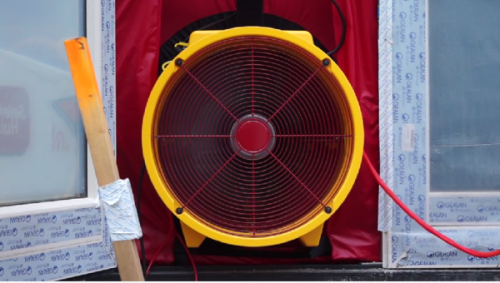Airtightness of homes determined

The airtightness of many Dutch homes will be determined thanks to researchers from the University of Twente. Based on more than one hundred reports of 'blower door tests' (which determine the airtightness of a home) that have been made available by companies, the University aims to make recommendations in the field of airtightness for municipalities and builders.
Bram Entrop, lecturer in Sustainable Building at the University of Twente, is gathering a wealth of data on the airtightness of homes. In his 'Impenetrable infiltration' study, which is part of the 3TU Lighthouse programme, he sketches an overall picture of the current airtightness of new Dutch homes, together with the Technical University of Eindhoven and construction firm SelektHuis.
No complete picture available
"Why are we doing that?" We have been imposing energy performance requirements on homes since 1995. There are now several (private) companies that actually check the airtightness of buildings and therefore perform measurements", says Entrop. "However, the individual reports by the principals do not provide a complete picture of the Netherlands. Homes must comply with a so-called 'energy performance coefficient', but at the moment no-one seems to be performing an overall check whether the required or desired airtightness is achieved. In practice, homes still have various leaks. Obviously, ventilation must be good, but besides the ventilation system you actually want the house to be as airtight as possible, so there are no complaints about comfort and no unnecessary energy loss."
3TU Bouw Impenetrable Infiltration - Test 141006 from 3TU.Bouw on Vimeo.
No accusing finger
Entrop in particular wants to facilitate understanding of the collected data. Not by pointing an accusing finger at a particular contractor or building physics consultant, but by spotlighting general characteristics and common concerns. "We want to provide feedback about this using the latest means of communication, such as our website and social media. After all, a contractor does not want to wade through a 150-page research report, but immediately, preferably online, see what has to take place if an improvement is required."
Blower door test
The data that Entrop gathers is derived from blower door tests in new homes. A blower door test measures the airtightness of a home. This involves sealing the door opening with a tarpaulin and ventilator, which is connected to an air pressure gauge. By incrementally creating underpressure and overpressure, the airtightness of a building is determined. Leaks are detected with the aid of smoke or an infrared camera. Infiltration (i.e. uncontrolled ventilation) occurs where connections between building parts are not airtight. Entrop and his colleagues were present during such tests and also conducted these themselves. Furthermore, they want to change the protocol for these tests so that they are more detailed and reliable.
More information
The 'Impenetrable infiltration' research is financed from a 3TU Lighthouse project with cooperation from TU Eindhoven researchers. Bram Entrop obtained his doctoral degree at the University of Twente in 2013 and subsequently became a university lecturer. In his doctoral thesis, he concluded that not all new energy technologies in homes lead to a structural decrease in energy costs unfortunately. Moreover, he stated that it is difficult for new, innovative energy technologies for buildings to capture a place on the Dutch market.
More information: www.utwente.nl/luchtdichtheid
Provided by University of Twente




















